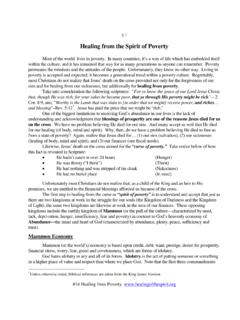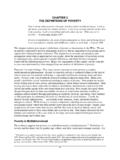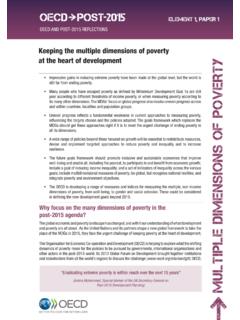Transcription of Chapter 4. Measures of Poverty - World Bank
1 Chapter 4. Measures of Poverty Summary Assume that information is available on a welfare measure such as income per capita, and a Poverty line, for each household or individual. This Chapter explains how one may then construct summary Measures of the extent of Poverty . The headcount index (P0) Measures the proportion of the population that is poor. It is popular because it is easy to understand and measure . But it does not indicate how poor the poor are. The Poverty gap index (P1) Measures the extent to which individuals fall below the Poverty line (the Poverty gaps) as a proportion of the Poverty line. The sum of these Poverty gaps gives the minimum cost of eliminating Poverty , if transfers were perfectly targeted.
2 The measure does not reflect changes in inequality among the poor. The squared Poverty gap ( Poverty severity ) index (P2) averages the squares of the Poverty gaps relative to the Poverty line. It is one of the Foster-Greer-Thorbecke (FGT) class of Poverty Measures that may be written as . 1 N. Gi . P =. N.. i =1 z .. where N is the size of the sample, z is the Poverty line, Gi is the Poverty gap and is a parameter; when is larger the index puts more weight on the position of the poorest. The Sen-Shorrocks-Thon index is defined as PSST = P0 P1P (1 + G P ). where P0 is the headcount index, P1P is the Poverty gap index for the poor only, and GP is the Gini index for the Poverty gaps for the whole population.
3 This measure allows one to decompose Poverty into three components and to ask: Are there more poor? Are the poor poorer? And is there higher inequality among the poor? Other Measures of Poverty are available. The time taken to exit Measures the average time it would take for a poor person to get out of Poverty , given an assumption about the economic growth rate; it may be obtained as the Watts Index divided by the growth rate of income (or expenditure) of the poor. Learning Objectives After completing the module on Measures of Poverty , you should be able to: c. Describe and explain the headcount index, indicate why it is popular, and explain why it is an imperfect measure of Poverty . d. Describe and compute the Poverty gap and Poverty severity indexes, and evaluate their adequacy as Measures of Poverty .
4 E. Explain and evaluate the FGT (Foster-Greer-Thorbecke) family of Poverty Measures . f. Compute the Sen and Sen-Shorrocks-Thon indexes of Poverty , and show how the latter may be decomposed to identify the sources of changes in Poverty . g. Compute the Watts index and the related Time-Taken-To-Exit measure . h. Argue that there is no single best measure of Poverty . Poverty Manual, All, JH Revision of August 8, 2005 Page 69 of 218. Given information on a welfare measure such as per capita consumption, and a Poverty line, then the only remaining problem is deciding on an appropriate summary measure of aggregate Poverty . There are a number of aggregate Measures of Poverty that can be computed. The formulas presented here are all based on the assumption that the survey represents a simple random sample of the population, which makes them relatively easy to understand.
5 Where the sampling is more complex the typical situation in practice weighting is needed, and the relevant formulas and associated programming are somewhat more difficult, but can be handled fairly easily by most major statistical packages such as Stata and SPSS. Headcount index By far the most widely-used measure is the headcount index, which simply Measures the proportion of the population that is counted as poor, often denoted by P0. Formally, Np ( ) P0 =. N. where Np is the number of poor and N is the total population (or sample). If 60 people are poor in a survey that samples 300 people, then P0 = 60/300 = = 20%. For reasons that will be clearer below, it is often helpful to rewrite ( ) as N. 1. ( ) P0 =.
6 N. I(y i =1. i < z ), Here, I(.) is an indicator function that takes on a value of 1 if the bracketed expression is true, and 0. otherwise. So if expenditure (yi) is less than the Poverty line (z), then I(.) equals to 1 and the household would be counted as poor. Np is the total number of the poor. The greatest virtues of the headcount index are that it is simple to construct and easy to understand. These are important qualities. However the measure has at least three weaknesses: First, the headcount index does not take the intensity of Poverty into account. Consider the following two income distributions: Headcount Poverty Rates in A and B, assuming Poverty line of 125. Expenditure for each individual in country Headcount Poverty rate (P0).
7 Expenditure in country A 100 100 150 150 50%. Expenditure in country B 124 124 150 150 50%. Clearly there is greater Poverty in country A, but the headcount index does not capture this. As a welfare function, the headcount index is unsatisfactory in that it violates the transfer principle an idea Poverty Manual, All, JH Revision of August 8, 2005 Page 70 of 218. first formulated by Dalton (1920) that states that transfers from a richer to a poorer person should improve the measure of welfare. Here if a somewhat poor household were to give to a very poor household, the headcount index would be unchanged, even though it is reasonable to suppose that Poverty overall has lessened. Some argue that if it is to meaningful, the headcount index should imply that there is a jump or discontinuity in the distribution of welfare at about the Poverty line, so it makes sense to speak of the poor and the non-poor.
8 In practice, such a jump is not found (Ravallion 1996, ). Second, the head-count index does not indicate how poor the poor are, and hence does not change if people below the Poverty line become poorer. Moreover, the easiest way to reduce the headcount index is to target benefits to people just below the Poverty line, because they are the ones who are cheapest to move across the line. But by most normative standards, people just below the Poverty line are the least deserving of the poor. Third, the Poverty estimates should be calculated for individuals and not households. If 20% of households are poor, it may be that 25% of the population is poor (if poor households are large) or 15%. are poor (if poor households are small); the only relevant figures for policy analysis are those for individuals.
9 But survey data are almost always related to households, so in order to measure Poverty at the individual level we must make a critical assumption that all members of a given household enjoy the same level of well-being. This assumption may not hold in many situations. For example, some elderly members of a household, or girls, may be much poorer than other members of the same household. In reality, not all consumption is evenly shared across household members. Poverty gap index A moderately popular measure of Poverty is the Poverty gap index, which adds up the extent to which individuals on average fall below the Poverty line, and expresses it as a percentage of the Poverty line. More specifically, define the Poverty gap (Gi) as the Poverty line (z) less actual income (yi) for poor individuals; the gap is considered to be zero for everyone else.
10 Using the index function, we have Poverty Manual, All, JH Revision of August 8, 2005 Page 71 of 218. ( ) Gi = ( z yi ).I ( yi < z ). Then the Poverty gap index (P1) may be written as N. 1 Gi ( ) P1 =. N.. i =1 z . This table shows how the Poverty gap is computed, divided by the Poverty line, and averaged to give P1, the Poverty gap index. Calculating the Poverty Gap Index, assuming Poverty line of 125. Expenditure for each individual in country Poverty Gap Index (P1). Expenditure in country C 100 110 150 160. Poverty gap 25 15 0 0. Gi/z 0 0 [= ]. This measure is the mean proportionate Poverty gap in the population (where the non-poor have zero Poverty gap). Some people find it helpful to think of this measure as the cost of eliminating Poverty (relative to the Poverty line), because it shows how much would have to be transferred to the poor to bring their incomes or expenditures up to the Poverty line (as a proportion of the Poverty line).















